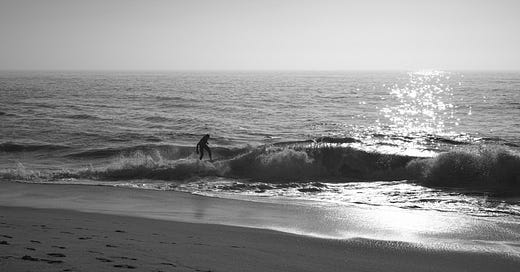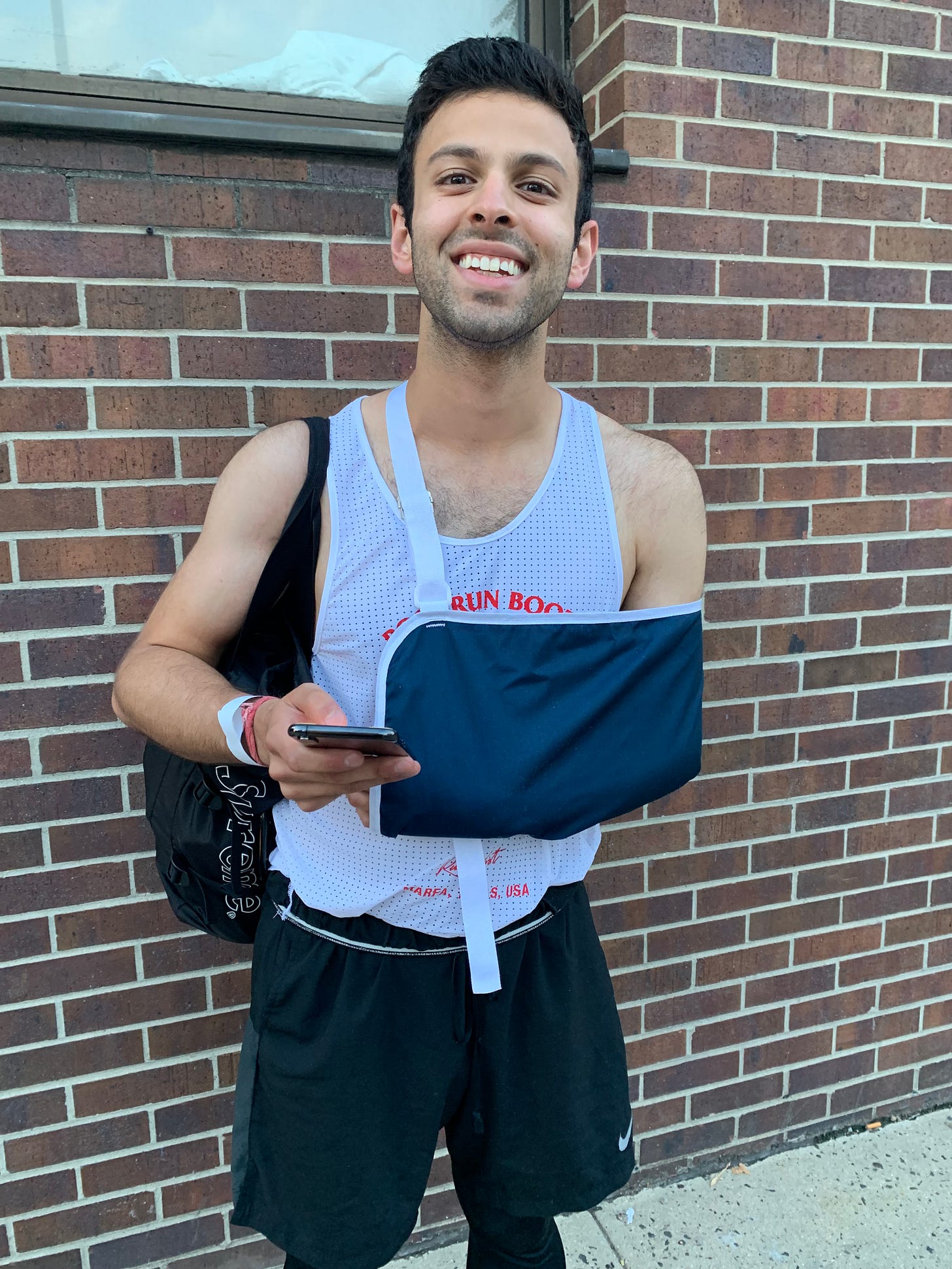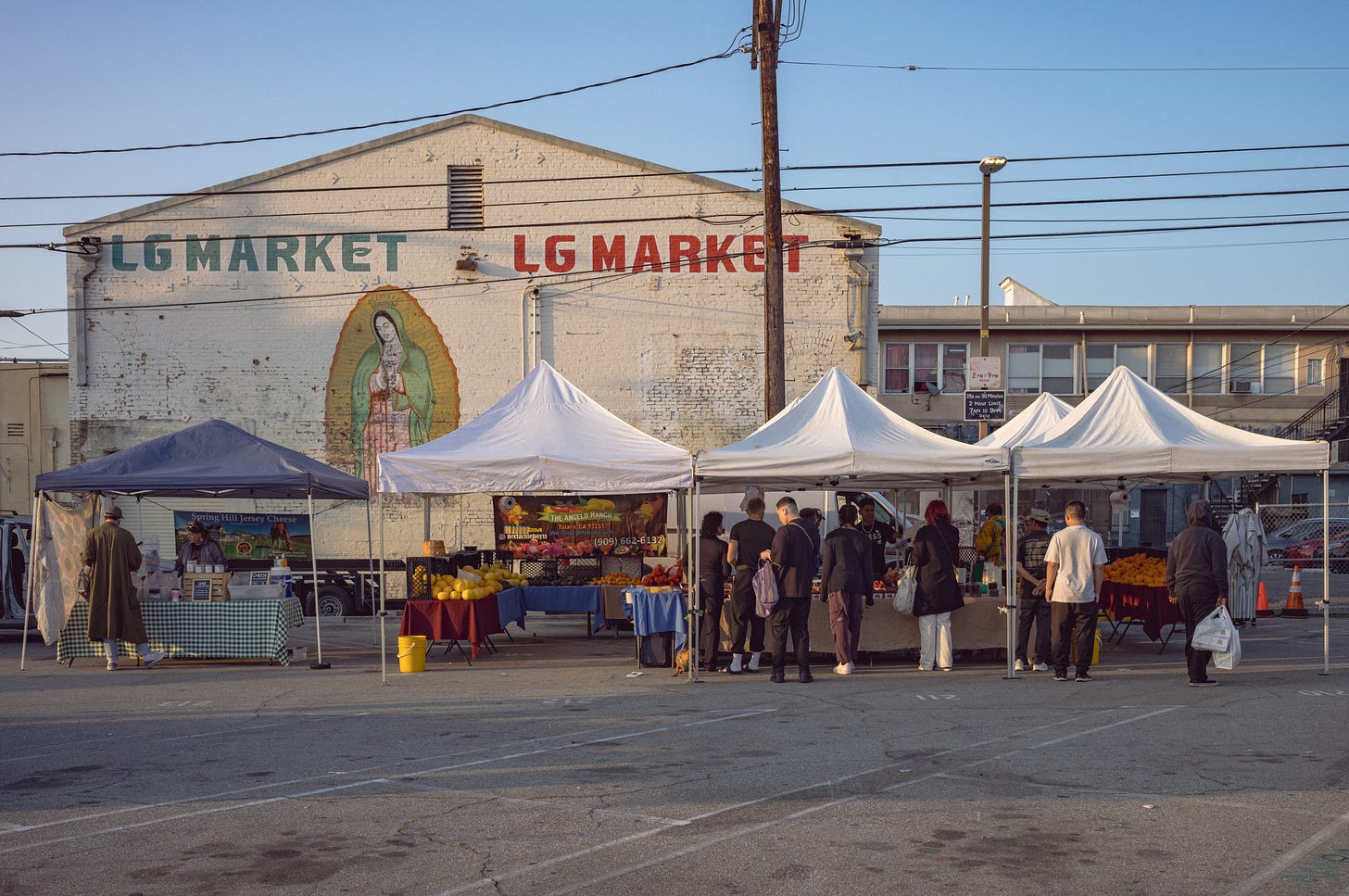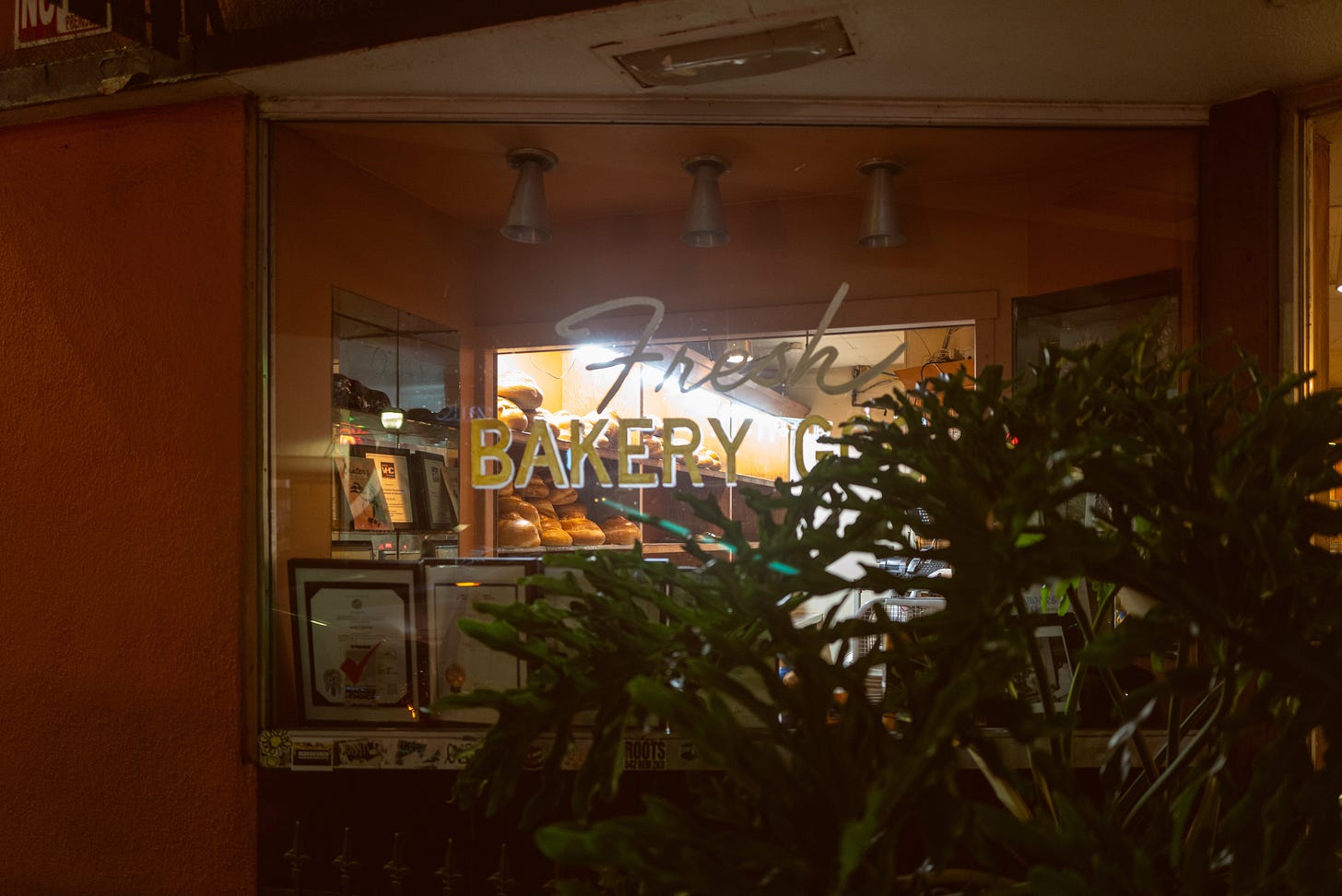I don’t have much feeling beyond my left forearm. (More on this later.)
Depending on the day, this is a blessing or a curse.
Today, certainly a blessing.
Two things had gone wrong in quick succession.
First, I had sliced into my thumb as I was prepping ingredients. Oops. Note to self (and others): always use the mandolin guard.
Second, after bandaging my thumb, I proceeded to grab the handle of a (very) hot sauce pan. I didn't notice. I added a few knobs of butter and kept whisking, holding the handle.
When I finally looked down at my palm, it was glowing bright red.
Oops.
Scars, bruises, and calluses are sacrosanct in the kitchen; signs of battle-tested chefs who have “seen and survived shit”.1
This would be a good moment to remind you: I am not a battle-tested chef.
I have not seen nor survived shit — at the very least, not in the kitchen.
So, it’s a very fair question, dear reader, to ponder: where had I built up a pain tolerance that allowed me to slice my finger open and then unflinchingly grab onto a hot pan?
I wish there was a badass interjection here to the effect of: “Because I was born that way.”
But no, quite far from it (if my penchant for luxury hotels hadn’t given me away already).
No, my pain tolerance had been built up through the slow, iterative rips and tears to my poor, damage-prone body.
Fair warning to those who are squeamish or don’t like a lot of medical detail thrown their way (skip ahead):
I had a compound fracture in my left forearm when I was eighteen, the result of a running accident. Two surgeries later: two titanium plates and sixteen titanium screws are holding my arm together, and there are two gnarly scars to show for it. I was told I’d never be able to turn door handles, but a year of physical therapy, sheer will, and being eighteen meant that I am not just turning door handles, but actively turning my wrist when throwing my jab in boxing. One victim: my nerve endings are all out of whack below my elbow, so while I have full range of motion back, I can’t really feel heat or pain.
I have dislocated my left shoulder seven times. Thrice as a result of sparring bouts. Thrice as a result of boxing workouts (mostly bag work gone awry). And once because I lifted a suitcase awkwardly before I healed properly. If you’re reading this asking yourself why I go back to boxing: my family has the same question, and I couldn’t tell you. The unfortunate outcome here? See above: already damaged nerves, be damned.
I also happen to suffer from really bad, chronic migraines. Every time I say this out loud, I get the onslaught of WebMD advice. Have you tried Botox? Have you tried drinking more coffee? Have you tried x, y, z? My friend, I have tried everything you would care to read about and more. We may delve into this another time (if y’all are interested).
Long story incredibly long, I tolerate (physical) pain well because I’ve dealt with a lot of it.
This is not to say that pain is enjoyable.
And this is not to say that pain is inevitable.
Rather, it is to say that pain — all pain — can be tolerated.
I’m not a big believer in idioms about pain.
Does pain make us stronger? Maybe.
Is all pain temporary? Sure.
But at the end of the day, when you’re sitting in the emergency room in Brooklyn with a shoulder subluxation and you’re still in your sweaty, sweaty boxing gear, the last thing you’re thinking about is how much stronger you’ll be once this temporary pain has abated.
You want your damn shoulder back in place.
Pain isn’t noble. It isn’t transformative on its own.
It just is.
And if you’re lucky (or stubborn) you learn to carry it without letting it carry you.
You get stitched up. Pinned back together.
And then you go back — to sparring, to living, to cooking — not because you enjoy the pain, but because you know it’s not the end of the story.
Turns out (trite as it may be), pain’s part of the process — not the point of it.
So, when I found myself huddled over my Boos Block, thumb bloodied, palm bright red, it all seemed almost inevitable.
Not in a dramatic, “fate-has-cursed-me, woe-is-me!” sort of way.
But in a “I-think-I’m-learning-maybe?” kind of way.
After all, that’s what kitchens — real ones (even your fledgling home kitchen) — do.
They break you in. They bruise you. They humble you.
But they also teach you how to be more resilient, more patient.
Because pain in the kitchen isn’t just consequence. It’s instruction. It’s a builder of resilience.
It’s how you learn to cut straighter. To season better. To clean as you go.
So, yes, I cut my thumb and scorched my palm.
But I also finished dinner.
And that, to me, was progress.
I’m no authority. No grizzled line cook with forearms like tree trunks and a thousand-yard stare.
I’m still figuring it out — burning things, breaking things, occasionally making something beautiful.
But food’s taught me a few things. The hard way, mostly.
Here are three lessons I’ve learned so far — and how I learned them.
(Spoiler: pain makes a hell of a tutor.)
the trash bowl.
When I first embarked on the great “Rishi Culinary Quest” (self proclaimed), one of the recipes I earmarked was Gordon Ramsey’s Beef Wellington.
It’s actually not a complicated recipe, and I’d highly recommend it to any aspiring home chef.
But I decided to make it infinitely more complicated for myself by making everything (crepes, puff pastry, etc.) from scratch.
One of the early steps in the process is making a duxelles — a wonderfully umami blend of mushrooms, onions, herbs, and pepper that slowly cooks down into a paste.2
I was meticulously prepping mushrooms, shallots, and herbs — trimming, slicing, stacking. I’d toss the good stuff into one bowl, and the scraps collected next to my cutting board. Every few minutes, I’d collect the discard in my hands, walk over to the trash, dump, and reset. Over and over.
My back ached. My feet hurt. But I kept going.
After a few hours of this back and forth, I looked down at the floor. I winced. I had left a trail — stems, skins, scraps — like a mushroom-scented breadcrumb path from the counter to the trash can.
Oops.
It wasn’t just messy. It was inefficient. Awkward. Not to mention, ergonomically insane.
As I put the Dyson back in the closet, I rubbed the small of my back and it hit me: This is why every chef I follow swears by the trash bowl.
I know what you’re thinking.
That it took me hours to figure this out is... painful.
If this is why you hit “unsubscribe”, I get it. Totally fair.
But some of the best lessons arrive as humbling little personal eureka moments.
Obvious to everyone else.
Hard-won (and painful) for you.
know your [insert monger here].
When Anthony Bourdain released Kitchen Confidential, there was a Sinclair-esque reckoning.
Diners were forced to confront the ugly truths behind their favorite restaurants: Don’t order fish on Mondays. The bread’s probably recycled. Brunch is usually a scam.
There was also a quieter message about sourcing better ingredients.
I’ll be honest with you, dear reader: I ignored that part.
I read “better” as “more expensive” and waved it off with the arrogance of someone who had never truly suffered the consequences.
Until I did.
One night, I decided to make a “poke bowl” (yes, air quotes very much intended) using farmed salmon from a local supermarket.
I Googled what makes salmon “sushi grade.” Mistake number one.
I followed what I saw on Google. Mistake number two.
I’ll spare you the gory details. Let’s just say the bowl didn’t stay down.
Oops.
Lesson learned: ask questions.
Every time I try something new in the kitchen now, I ask.
What kind of fish is best for crudo?
How do I store this cut of meat?
What’s your go-to mustard?
And most importantly: I ask real people.
My butcher. My fishmonger. The guy who knows which fruits are actually in season.
Avoiding mild food poisoning is reason enough.
But honestly, so is eating better.
tote bags.
I have this distinct memory of my great uncle (my Dadai) carrying his jute tartan tote to the Sealdah Open Market at dawn.
I’d clutch his hand as we weaved through rickshaws, mopeds, and lorries, moving from stall to stall. Dadai would haggle gently, pass over a few rupees, nod once, cross another item off his mental checklist. The tartan bag would get a little heavier. And on we’d go.
We had it down to a science.
Once we’d gathered everything we needed, we’d make our final stop: picking up breakfast for the family.
Dadai would count out the last of his rupees and collect a warm bag from the vendor. But these didn’t go in the tote — they went straight to me.
“Hold onto them tightly, my child,” he’d say, passing over the clay pots, the bag warm against my chest.
He’d wrap an arm around my shoulder as we walked back to my grandmother’s house, just as everyone was waking up from their jet-lagged sleep.
That morning’s feast: luchi, khichuri, aloo dum, and my personal favorite — jalebi.
I miss my Dadai deeply.
He lived a long life, a full one. But even when you know it’s coming, even when it’s time, losing someone like that leaves a kind of quiet chasm.
You don’t just grieve the person.
You grieve the rituals.
The routes.
The way the world felt when they were in it.
On our most recent trip to India, I found myself once again carrying that same warm bag of puffed breads, lentils, and (of course) jalebi.
And though Dadai wasn’t beside me, I could hear his voice in my ear.
I felt the weight and warmth of the clay pots, and I held the bag a bit tighter.
And yes: I still had a tote bag slung over my shoulder, and a grocery list on my iPhone. Just like I do on every grocery run.
Some habits stay with you.
The good ones should.
en place.
Pain exists on a spectrum.
Some pains cut deep. Others just sting for a while.
Some you can ice and forget.
Others settle in and stay a while — years, maybe.
I told you I wasn’t going to wax poetic about pain, and I won’t.
It’s slippery. It wears you down. And eventually, it finds everyone.
But here’s the thing: we’re tougher than we think.
We adapt. We scar over. We figure it out.
Sometimes that looks like carrying a tote bag that reminds you of someone you loved.
Sometimes it’s a trash bowl that saves your feet and your sanity.
It doesn’t really matter what the pain is.
What matters is what you do next.
You clean up.
You reset.
You cook, again.
For a great write up in the Institute of Culinary Education Blog about this exact topic, read “What Chefs Really Think About Kitchen Scars” (June 23, 2017).
Look no further than this recipe and walkthrough from Alvin Zhou. I find Gordon Ramsay’s recipe(s) a bit hit/miss.









“It doesn’t really matter what the pain is. What matters is what you do next. You clean up. You reset. You cook, again.”
Beautiful.